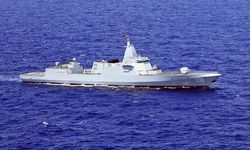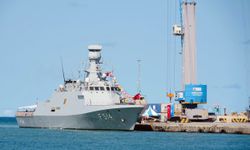Here is the article about keeping merchant vessels safe from attack.
The gunmen arrive seemingly out of nowhere, descending from a clear blue sky. Their helicopter swoops down towards a 190m-long (623ft) merchant ship in the Red Sea, a key waterway between the Arabian Peninsula and north-east Africa. As the aircraft touches down on the upper deck, masked attackers swarm out.
They're wearing black and khaki gear, aiming their machine guns along the deck as they pace towards the ship's bridge. Once they reach it, there's shouting, they point their weapons at the crew, who surrender with their arms aloft. This is a hijacking.
Iran-backed Houthi rebels took control of the Galaxy Leader, a car carrier, in the Red Sea at the end of November. It is one of the most serious maritime security incidents of recent years and is one example of escalating military activity in the Red Sea, associated with the Israel-Gaza war. The Houthis made sure to capture their hijacking on video, for public dissemination. The Galaxy Leader's crew, all 25 of them, remain captive while the vessel itself is anchored outside the port of Hodeidah in Yemen.
Since this incident, there have been several other attacks on merchant vessels in the Red Sea, with a Norwegian tanker – the MT Strinda – hit by a missile, and other ships in the area have reported being fired upon by armed men in speedboats.
People have long puzzled over how to secure merchant vessels against threats of violence – especially more common forms of attack, in which assailants use a small boat or boats to approach commercial ships rather than helicopters. Somali pirates became notorious for doing this in the early 2000s and a wide range of lethal and non-lethal weapons systems were deployed against them. What happened to all those gadgets? And are they of any use today, to ships sailing the world's most dangerous seas?
"It's a multi-pitched, very high frequency tone. Very loud," says Richard Danforth, chief executive of Genasys, a US-based tech company. "It'll make you want to cover your ears."
He is describing the capabilities of his firm's long range acoustic devices, known as LRADs, which Genasys – formerly the American Technology Corporation – introduced in the early 2000s. Danforth says the idea of an LRAD is to either allow for long-range communication of verbal warnings to suspects, or for broadcasting an unpleasant, disorienting tone at high volumes.
Some early LRAD devices were capable of hurling sound across a stretch of water at targets nearly 500m (1,640ft) away. Genasys claims its models are now capable of projecting sound up to 3,000m (9,843ft) while automatically tracking the target.
The company claims that their system can work even if assailants wear ear protection. "Because much of human hearing is processed from the vibration of the small bones in your face and jaw, earplugs or headphones do little to reduce LRAD's effects," a spokesman says.
Danforth adds that some large commercial vessels, including container ships, are currently sailing with LRAD systems installed. Some of these are set up so that crew members can remotely control them from the bridge – to aim them, for instance, at a boatload of incoming pirates. LRADs are also used by the US Navy, some nuclear power plants, wealthy yacht owners and one system is even in place at the Hoover Dam on the Colorado River, according to Danforth.
But reports in 2008 suggested that an LRAD system was ineffective when Somali pirates hijacked the MV Biscaglia, a chemical tanker, although Genasys says the LRAD was never deployed during the incident. The security team defending the ship was forced to jump overboard. Separately, the crew of a cruise ship in 2005 reported successfully using LRAD and other techniques to fend off Somali pirates after the vessel was attacked with rocket launchers.
Source: BBC.com






